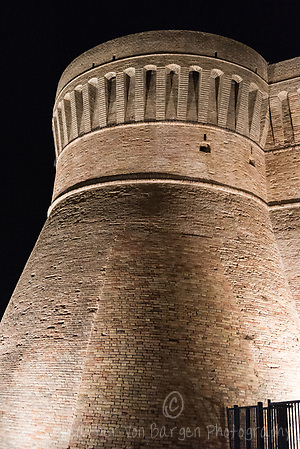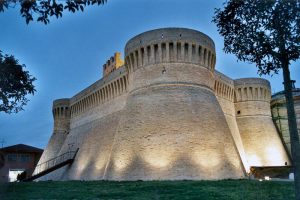
It was dark the first time we went to Urbisaglia, a partially walled hilltop town. My husband Matt and I walked toward the piazza, following dubious GPS coordinates. To our left a tall round tower was illuminated. I deviated down the side street to approach it. Behind it loomed a massive castle.
We couldn’t stay. We had dinner reservations—as it turns out, down the hill on the main highway. The enchanting village of Urbisaglia would have to wait.
Urbs Salvia was an important Roman city, likely founded in the first century BC at the crossroads of two major routes that spanned the region. Roman walls still stand guard along the main highway at the bottom of the hill, now an archeological park. Remarkably preserved ruins include temples, a theater, and an amphitheater that held gladiatorial events. Every summer, actors perform classical plays in the amphitheater.

The Visigoths destroyed Urbs Salvia in 409 AD, and the citizens fled up the hill for safety. The lower city’s prosperity was preserved under a landslide for future discovery. Dante writes about Urbisaglia’s demise in Paradiso: “…Seeing that even cities have an end.”
The castle on the top of the hill was finished in 1507, built on the site of ancient Roman remnants and hints of a twelfth century fortification. It is an asymmetrical trapezoid with four towers at the corners. We had passed the largest one.
Built by the city of Tolentino, who ruled Urbisaglia at the time, the castle’s layout was designed to not only defend against outside threats, but also to repress internal rebellion from the resentful citizens of Urbisaglia who wanted autonomy. They would not obtain it until 1569.

Called La Rocca, the castle overshadows the city’s main Piazza Garibaldi. An adjacent church faces the piazza. On the opposite side is a bakery we go to for an aperitivo. Matt always orders a spritz. He says the guy there makes a good one. I always order a prosecco. We sit outside, always at the same table, the one closest to the church. It’s become “ours.”
Waiting for my drink, I go to the cash machine across the street to my right. It’s molasses slow but reliable. The pharmacy, a post office, and a clothing store are on the left side of the piazza. A good restaurant is down the block. A gelateria and another bar is on our walk back to the car.
The waiter carries our drinks with the reverence of an offering plate. Or it could be that he does not want my prosecco to tip over. His tray is laden with small pizza triangles, focaccia rectangles, potato chips, olives, peanuts, and breads of all sorts. I picture him looking at what he has on hand and deciding what freshly baked goods we should try this time. He plates it just so. It’s his work. That and Italians never drink alcohol without food.
We arrive after school is out and before dinner starts. We can smell it cooking. Young kids play soccer in the square. They make up rules Matt understands and he explains them to me. The ball hits the church frequently. It flies our way often. Once, the ball hit the bakery’s facade and I thought the door would break. One time, the ball went through the open door and into the store.
Men gather and talk politics. I try not to eavesdrop but pick up helpful phrases. Mothers arrive, yelling “ragazzi, ragazzi,” to collect their children. One evening a woman apologized to me (in Italian!) for the noise. I replied that it was fun for us. At least that’s what I hope I said.
A grandmother and her cat peered out from a balcony window in the same pose and I could not bring myself to raise my camera. It would intrude. I realize now I have no pictures of this piazza, our favorite aperitivo place. In Urbisaglia, despite my huge camera, I am not a turista. I am a non-local.
Our country house is technically under Tolentino’s jurisdiction, although we are equidistantly 15 minutes from Urbisaglia and Tolentino. We do our shopping and business in the higher-populated Tolentino. But Urbisaglia is where we relax under the fortress that protected a city worth fighting for.

2 thoughts on “Aperitivi in Urbisaglia”